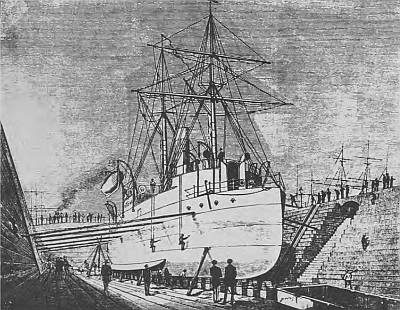- Author
- Webb, P
- Subjects
- None noted
- Tags
-
- RAN Ships
- None noted.
- Publication
- August 1972 edition of the Naval Historical Review (all rights reserved)
Naval brigade gun teams exercised in Nelson for the first time on 10th September 1870. They were unpopular on the eastern shore of the bay in 1877, when they loosed a projectile which landed at the railway station entrance, narrowly missing killing a Chinese.
Nelson took part in a mock attack on Williamstown batteries in 1876. All arms of the services took part in the exercise and there were about 2,000 to 3,000 troops deployed around the Bay. Nelson landed a task force of the Naval Reserve below Brighton and proceeded to attack the Williamstown batteries which were declared destroyed because their guns could not be brought to bear on the vessel. Nelson at this time carried two 116-pdrs., twenty 64-pdrs., 20 smooth bore 32-pdrs. and six 12 pdrs.

HMVS Cerberus, laid down at Palmers yard on 1st September 1867, was launched on 2nd December 1868. Completed in September 1870, she sailed from Plymouth on 8th November. As her maximum coal capacity of 210 tons was inadequate for the voyage out to Melbourne, temporary sides were built up to the breastwork and she was given a full three-masted rig. She arrived off Williamstown on 9th April 1871 after a passage largely under sail.
Cerberus displaced 3,340 tons. With a length of 225 feet, her hull had a freeboard of only 3½ feet, with a central armoured breastwork amidships rising 7 feet above the deck. She carried four 18-ton 10-inch Woolwich muzzle-loading rifled guns in her two turrets, with several Gatling machine guns mounted on the superstructure. She had her square-box pattern boilers removed in 1883 and replaced by cylindrical boilers which gave her a top speed of 9 knots, or a knot less than her original speed.
Cerberus was used as an explosives store ship for about 30 years until 1921, when she was towed to Geelong for use as depot ship for the newly formed submarine base. She was rechristened Platypus II. She was later sold for little more than forty pounds and towed from Corio Bay to Williamstown Dockyard on 14th May 1924 for dismantling. She was purchased from the Melbourne Salvage Company by the Brighton Yacht Club and used to form a breakwater at Black Rock.
Victorian Naval expenditure in 1865 was £7,743, which rose to £17,135 by 1875. This did not allow for the £73,520 towards the cost of Cerberus and £28,520 for Nelson. The naval strength was then 20 officers, 284 petty officers and seamen, and 40 boy seamen. Naval Reserve strength mustered aboard Nelson for shot and shell practice in 1883 was 216 officers and men.

The next year the first class torpedo boat Childers joined the fleet, armed with four torpedoes for releasing over the side by dropping gear, and two Hotchkiss guns. The same year the steam hoppers Batman and Fawkner of the Melbourne Harbour Trust were added to the fleet as auxiliaries. Batman mounted a 14-ton gun and two Nordenfelts, while Fawkner was fitted with a 4-ton gun and two Gatlings.
The fleet in 1889 consisted of Nelson, Cerberus, Batman, Fawkner, Childers, Nepean, Lonsdale, Victoria, Albert, Gordon, Commissioner, Lion, Gannet and Lady Loch. Nepean and Lonsdale were second class torpedo boats each armed with two Whitehead and two spar torpedoes. The gunboat Albert was of 350 tons displacement with 400 IHP engines driving her at 10 knots. She was built of steel with a turtle deck and a bridge deck amidships enclosing the engines. She was armed with a 12.5 ton 8 inch gun forward and a 4.5 ton breechloader aft. She also mounted two 9 pdrs. and two Nordenfelt machineguns.

The larger vessel, Victoria, was 530 tons and mounted one 10 inch gun, two 12 pdrs. and two Nordenfelts. Both gunboats were meant for harbour defence and behaved very badly in rough weather, or indeed, with any sea running at all. Victoria was sold to the West Australian Government in 1896.
The Customs steam launch Lion and the Harbour Trust launch Commissioner, when operating with the Victoria Navy, each carried two Whitehead torpedoes. The Harbour Trust tug Gannet mounted a 14 ton gun and two Gatlings. Lady Loch was built for the Department of Trade and Customs, and as a Victorian Navy vessel mounted a 4 ton gun and two Nordenfelts.
Gordon was a turnabout torpedo launch armed with two Whitehead torpedoes and a Nordenfelt. There was also Pharos, a composite auxiliary screw steamer built at Williamstown in 1865. She was brigantine rigged and built for survey purposes but was found to be totally unsuitable, and the old Colonial Victoria was recommissioned from reserve. Pharos was chiefly used for laying buoys and carrying stores to lighthouses and telegraph stations. She was sold out of Government service and was used as a tug and excursion steamer before finishing her life as a hulk. The Government tugs Bendigo and George Rennie, both sidewheel paddle steamers, also operated with the Victorian Navy for varying periods.




